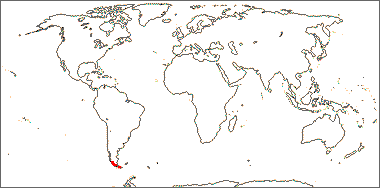Family name: Philesiaceae Dumort.
Synonym(s): Lapageriaceae Kunth
Common name(s): philesia family
*Number of genera/species: 2/2
List of genera records in GRIN-Global
fruit
Fruit a berryberry:
an indehiscent, fleshy fruit with one or a few to many seeds. The flesh may be homogenous throughout. Or, if the outer part is hard, firm, or leathery, referred to as an hesperidium. Septa are present in some, and the seeds may be arillate or with a fleshy testa. , globoseglobose:
, globoseglobose:
3D shape—more or less spherical , ovoidovoid:
, ovoidovoid:
3D shape—ovate , or ellipsoidellipsoid:
, or ellipsoidellipsoid:
3D shape—elliptic
, triangulartriangular:
2D shape—three relatively straight sides with distinct corners; more angular than teardrop-shaped in transection, beakedbeak:
in transection, beakedbeak:
a usually firm, terminal appendage, sometimes tapered , bracts and stylesstyle:
, bracts and stylesstyle:
in a flower, the narrow and elongated part of the pistil between the stigma and the ovary; sometimes persisting in fruit persistent, with few to many seeds. Pericarppericarp:
persistent, with few to many seeds. Pericarppericarp:
fruit wall or fruit coat
red, fleshy, smooth.
Seeds globoseglobose:
3D shape—more or less spherical or ovoidovoid:
or ovoidovoid:
3D shape—ovate . Seed coat yellowish brown.
. Seed coat yellowish brown.
Embryo curvedcurved:
(of embryo) linear embryo is curved into an arch or horseshoe with the ends far apart , about 1/2 the length of the seed.
, about 1/2 the length of the seed.
Endosperm copious.
| Fruit | |
| Type | berryberry: an indehiscent, fleshy fruit with one or a few to many seeds. The flesh may be homogenous throughout. Or, if the outer part is hard, firm, or leathery, referred to as an hesperidium. Septa are present in some, and the seeds may be arillate or with a fleshy testa.  |
| Size range | ~25 mm long |
| Shape(s) | ovoidovoid: 3D shape—ovate  , globoseglobose: , globoseglobose:3D shape—more or less spherical  , ellipsoidellipsoid: , ellipsoidellipsoid:3D shape—elliptic |
| Texture | fleshy |
| Surface relief | smooth |
| Color(s) | red |
| Unique features | Red, tough skinned, smooth, fleshy, beakedbeak: a usually firm, terminal appendage, sometimes tapered  berries with persistent bracts at the base and few to numerous seeds. berries with persistent bracts at the base and few to numerous seeds. |
| Seed | |
| Shape(s) | globoseglobose: 3D shape—more or less spherical  , ovoidovoid: , ovoidovoid:3D shape—ovate  |
| Color(s) | yellow brown |
| Other | |
| Embryo | curvedcurved: (of embryo) linear embryo is curved into an arch or horseshoe with the ends far apart  , about 1/2 the length of the seed , about 1/2 the length of the seed |
| Nutritive tissue | endosperm copious |
Southern Chile.

Distribution map courtesy of Angiosperm Phylogeny Website.
Baskin and Baskin 2021Baskin and Baskin 2021:
Baskin C and Baskin J. 2021. Relationship of the lateral embryo (in grasses) to other monocot embryos: A status up-grade. Seed Science Research 31 (3): 199-210. doi:10.1017/S0960258521000209; Dahlgren et al. 1985Dahlgren et al. 1985:
Dahlgren RMT, Clifford HT, and Yeo PF. 1985. The families of the monocotyledons: structure, evolution, and taxonomy. Springer-Verlag, Berlin. 520 pp.; Kirkbride et al. 2006Kirkbride et al. 2006:
Kirkbride JH, Jr, Gunn CR, and Dallwitz MJ. 2006. Family guide for fruits and seeds, vers. 1.0. Accessed September 2020-January 2022. URL: https://nt.ars-grin.gov/seedsfruits/keys/frsdfam/index.cfm .; Kubitzki et al. 1990+Kubitzki et al. 1990+:
Kubitzki K et al., eds. 1990+. The families and genera of vascular plants. 7+ vols. Berlin etc.; Stevenson and Loconte 1995Stevenson and Loconte 1995:
Stevenson DW and Loconte H. 1995. A cladistic analysis of monocot families. In: Rudall PJ, Cribb PJ, Cutler DF, and Humphries CJ, eds. Monocotyledons: Systematics and Evolution. Royal Botanic Gardens, Kew.; Takhtajan 2009Takhtajan 2009:
Takhtajan A. 2009. Flowering plants: Second edition. Springer Nature, Switzerland. 871 pp.; Watson and Dallwitz 1992+Watson and Dallwitz 1992+:
Watson L and Dallwitz MJ. 1992+. The families of flowering plants: descriptions, illustrations, identification, and information retrieval. Version: 6th Accessed September 2020-September 2022. URL: delta-intkey.com
*The number of genera and species is based on Christenhusz and Byng 2016Christenhusz and Byng 2016:
Christenhusz MJM and Byng JW. 2016. The number of known plant species in the world and its annual increase. Phytotaxa 261 (3): 201-217. https://doi.org/10.11646/phytotaxa.261.3.1, which may differ from the number of genera in GRIN-Global.